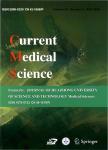Measurement and Clinical Significance of Endothelin inNeonatal Urine
Measurement and Clinical Significance of Endothelin in Neonatal Urine作者机构:Department of Pediatrics Tongji Hospital Tongji Medical University Wuhan
出 版 物:《Journal of Huazhong University of Science and Technology(Medical Sciences)》 (华中科技大学学报(医学英德文版))
年 卷 期:1997年第17卷第3期
页 面:140-143页
核心收录:
学科分类:1010[医学-医学技术(可授医学、理学学位)] 10[医学]
主 题:infants newborn endothelin perinatal asphyxia renal function test
摘 要:The present study was undertaken to figure out the source of urinary endothelin (ET) and the clinical significance of its possible variations. Urinary ET levels were measured by radioimmunoassay (RIA) in 17 healthy newborns and 20 asphyxiated neonates on days 1, 3, 7 after birth. Plasma ET concentrations of healthy premature infants on day 7 and urinary ET levels in 10 healthy children were also observed at the same time. Results showed that: (1) Urinary ET levels and ET excretion rates were higher than plasma ET in preterm infants on days 7 after birth; (2) Both in preterm and full term infants, urinary ET concentrations fell from the 1st day to the 7th day after birth. ET excretion rates elevated markedly at the end of the 1st week, and they were significantly higher than that of children; (3) Urinary ET levels of asphyxiated group on days 1 and 3 were much higher than those of healthy neonates, and positively correlated with the severity of the illness and urinary NAG. We conclude that: (1) urinary ET mainly comes from the production in renal cells; (2) ET levels in healthy neonatal urine reflect the maturity of kidney: (3) measurement of urinary ET levels in asphyxiated neonates is helpful to judge the degree and to evaluate the prognosis of renal injury.



